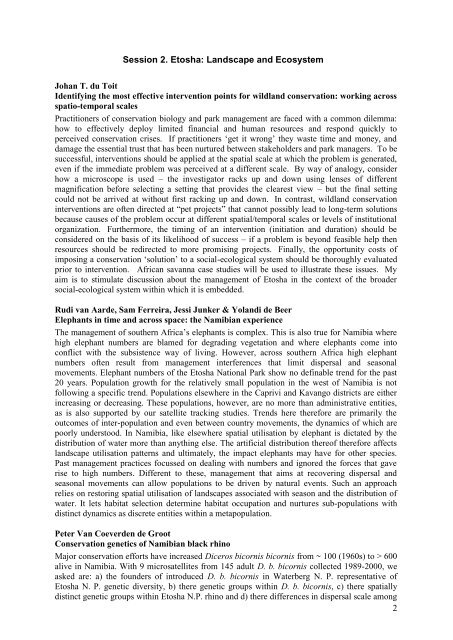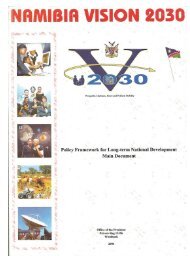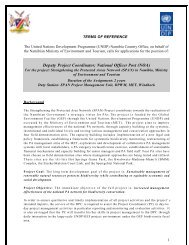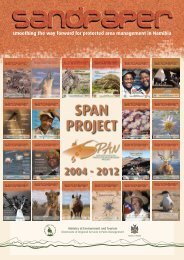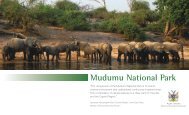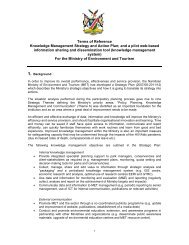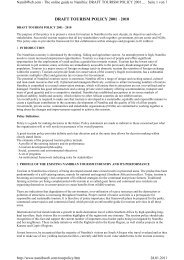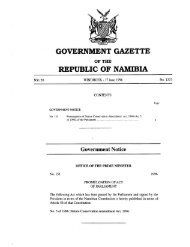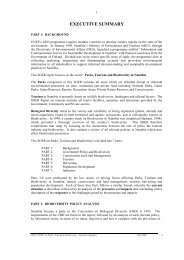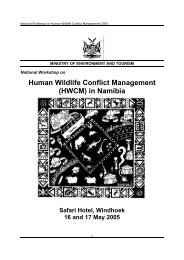Etosha: the Human Footprint - Ministry of Environment and Tourism
Etosha: the Human Footprint - Ministry of Environment and Tourism
Etosha: the Human Footprint - Ministry of Environment and Tourism
Create successful ePaper yourself
Turn your PDF publications into a flip-book with our unique Google optimized e-Paper software.
Session 2. <strong>Etosha</strong>: L<strong>and</strong>scape <strong>and</strong> Ecosystem<br />
Johan T. du Toit<br />
Identifying <strong>the</strong> most effective intervention points for wildl<strong>and</strong> conservation: working across<br />
spatio-temporal scales<br />
Practitioners <strong>of</strong> conservation biology <strong>and</strong> park management are faced with a common dilemma:<br />
how to effectively deploy limited financial <strong>and</strong> human resources <strong>and</strong> respond quickly to<br />
perceived conservation crises. If practitioners „get it wrong‟ <strong>the</strong>y waste time <strong>and</strong> money, <strong>and</strong><br />
damage <strong>the</strong> essential trust that has been nurtured between stakeholders <strong>and</strong> park managers. To be<br />
successful, interventions should be applied at <strong>the</strong> spatial scale at which <strong>the</strong> problem is generated,<br />
even if <strong>the</strong> immediate problem was perceived at a different scale. By way <strong>of</strong> analogy, consider<br />
how a microscope is used – <strong>the</strong> investigator racks up <strong>and</strong> down using lenses <strong>of</strong> different<br />
magnification before selecting a setting that provides <strong>the</strong> clearest view – but <strong>the</strong> final setting<br />
could not be arrived at without first racking up <strong>and</strong> down. In contrast, wildl<strong>and</strong> conservation<br />
interventions are <strong>of</strong>ten directed at “pet projects” that cannot possibly lead to long-term solutions<br />
because causes <strong>of</strong> <strong>the</strong> problem occur at different spatial/temporal scales or levels <strong>of</strong> institutional<br />
organization. Fur<strong>the</strong>rmore, <strong>the</strong> timing <strong>of</strong> an intervention (initiation <strong>and</strong> duration) should be<br />
considered on <strong>the</strong> basis <strong>of</strong> its likelihood <strong>of</strong> success – if a problem is beyond feasible help <strong>the</strong>n<br />
resources should be redirected to more promising projects. Finally, <strong>the</strong> opportunity costs <strong>of</strong><br />
imposing a conservation „solution‟ to a social-ecological system should be thoroughly evaluated<br />
prior to intervention. African savanna case studies will be used to illustrate <strong>the</strong>se issues. My<br />
aim is to stimulate discussion about <strong>the</strong> management <strong>of</strong> <strong>Etosha</strong> in <strong>the</strong> context <strong>of</strong> <strong>the</strong> broader<br />
social-ecological system within which it is embedded.<br />
Rudi van Aarde, Sam Ferreira, Jessi Junker & Yol<strong>and</strong>i de Beer<br />
Elephants in time <strong>and</strong> across space: <strong>the</strong> Namibian experience<br />
The management <strong>of</strong> sou<strong>the</strong>rn Africa‟s elephants is complex. This is also true for Namibia where<br />
high elephant numbers are blamed for degrading vegetation <strong>and</strong> where elephants come into<br />
conflict with <strong>the</strong> subsistence way <strong>of</strong> living. However, across sou<strong>the</strong>rn Africa high elephant<br />
numbers <strong>of</strong>ten result from management interferences that limit dispersal <strong>and</strong> seasonal<br />
movements. Elephant numbers <strong>of</strong> <strong>the</strong> <strong>Etosha</strong> National Park show no definable trend for <strong>the</strong> past<br />
20 years. Population growth for <strong>the</strong> relatively small population in <strong>the</strong> west <strong>of</strong> Namibia is not<br />
following a specific trend. Populations elsewhere in <strong>the</strong> Caprivi <strong>and</strong> Kavango districts are ei<strong>the</strong>r<br />
increasing or decreasing. These populations, however, are no more than administrative entities,<br />
as is also supported by our satellite tracking studies. Trends here <strong>the</strong>refore are primarily <strong>the</strong><br />
outcomes <strong>of</strong> inter-population <strong>and</strong> even between country movements, <strong>the</strong> dynamics <strong>of</strong> which are<br />
poorly understood. In Namibia, like elsewhere spatial utilisation by elephant is dictated by <strong>the</strong><br />
distribution <strong>of</strong> water more than anything else. The artificial distribution <strong>the</strong>re<strong>of</strong> <strong>the</strong>refore affects<br />
l<strong>and</strong>scape utilisation patterns <strong>and</strong> ultimately, <strong>the</strong> impact elephants may have for o<strong>the</strong>r species.<br />
Past management practices focussed on dealing with numbers <strong>and</strong> ignored <strong>the</strong> forces that gave<br />
rise to high numbers. Different to <strong>the</strong>se, management that aims at recovering dispersal <strong>and</strong><br />
seasonal movements can allow populations to be driven by natural events. Such an approach<br />
relies on restoring spatial utilisation <strong>of</strong> l<strong>and</strong>scapes associated with season <strong>and</strong> <strong>the</strong> distribution <strong>of</strong><br />
water. It lets habitat selection determine habitat occupation <strong>and</strong> nurtures sub-populations with<br />
distinct dynamics as discrete entities within a metapopulation.<br />
Peter Van Coeverden de Groot<br />
Conservation genetics <strong>of</strong> Namibian black rhino<br />
Major conservation efforts have increased Diceros bicornis bicornis from ~ 100 (1960s) to > 600<br />
alive in Namibia. With 9 microsatellites from 145 adult D. b. bicornis collected 1989-2000, we<br />
asked are: a) <strong>the</strong> founders <strong>of</strong> introduced D. b. bicornis in Waterberg N. P. representative <strong>of</strong><br />
<strong>Etosha</strong> N. P. genetic diversity, b) <strong>the</strong>re genetic groups within D. b. bicornis, c) <strong>the</strong>re spatially<br />
distinct genetic groups within <strong>Etosha</strong> N.P. rhino <strong>and</strong> d) <strong>the</strong>re differences in dispersal scale among<br />
2


